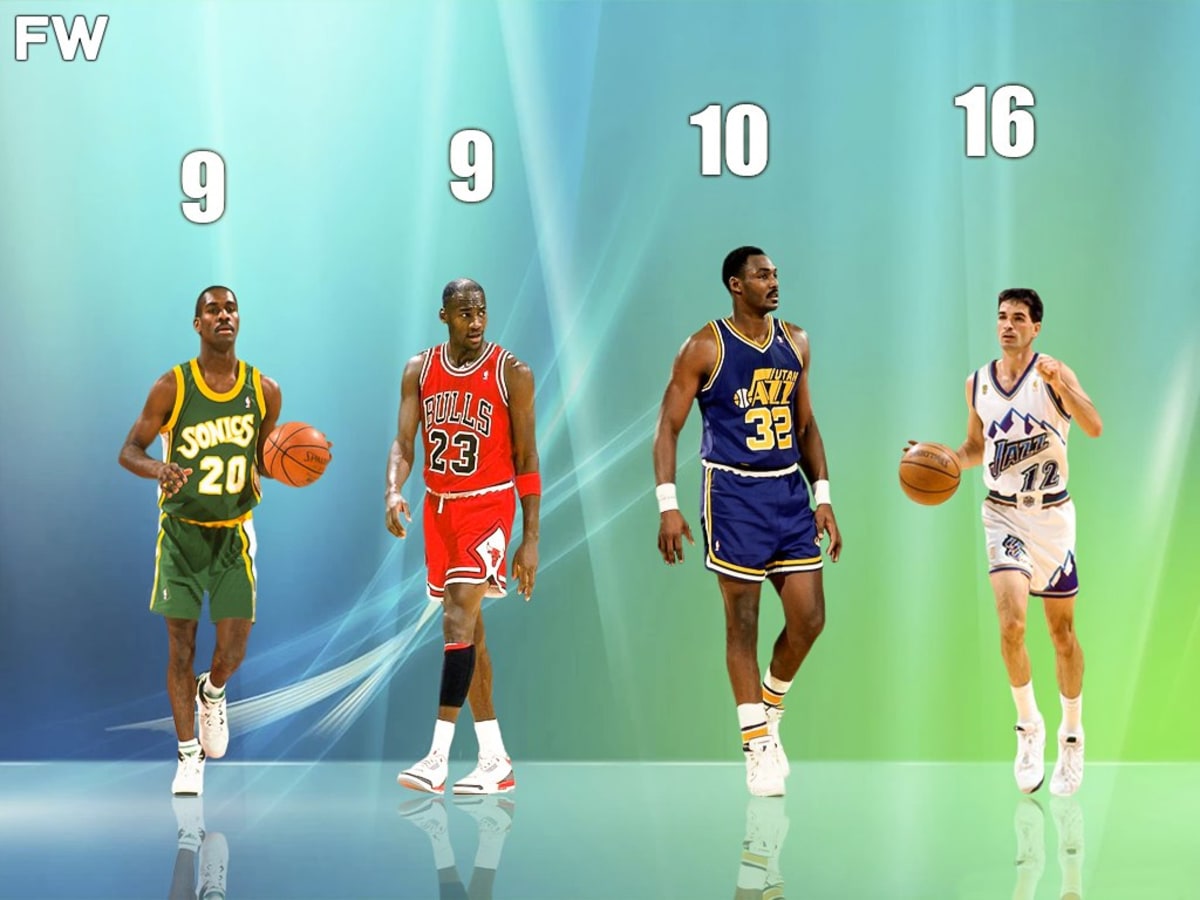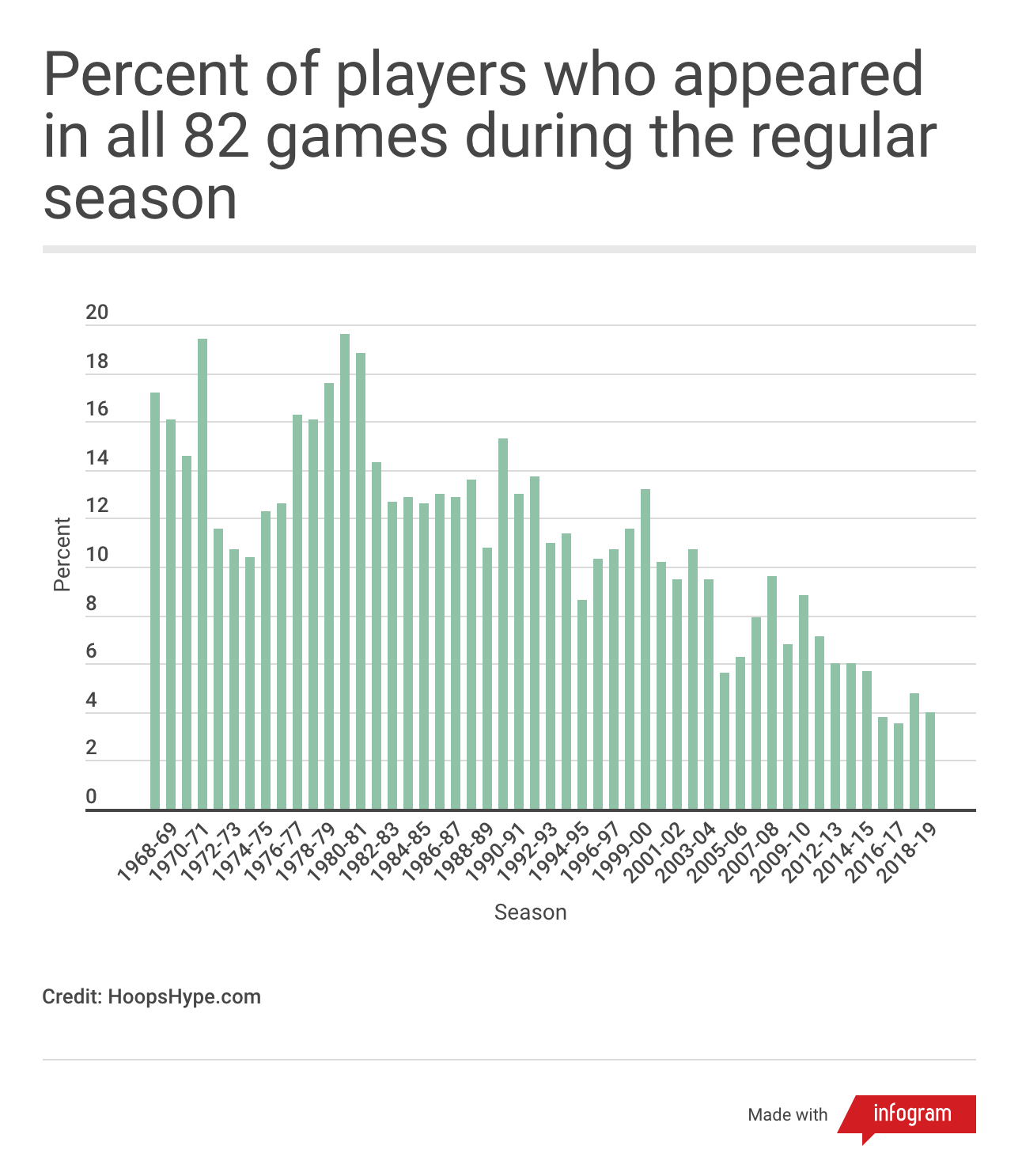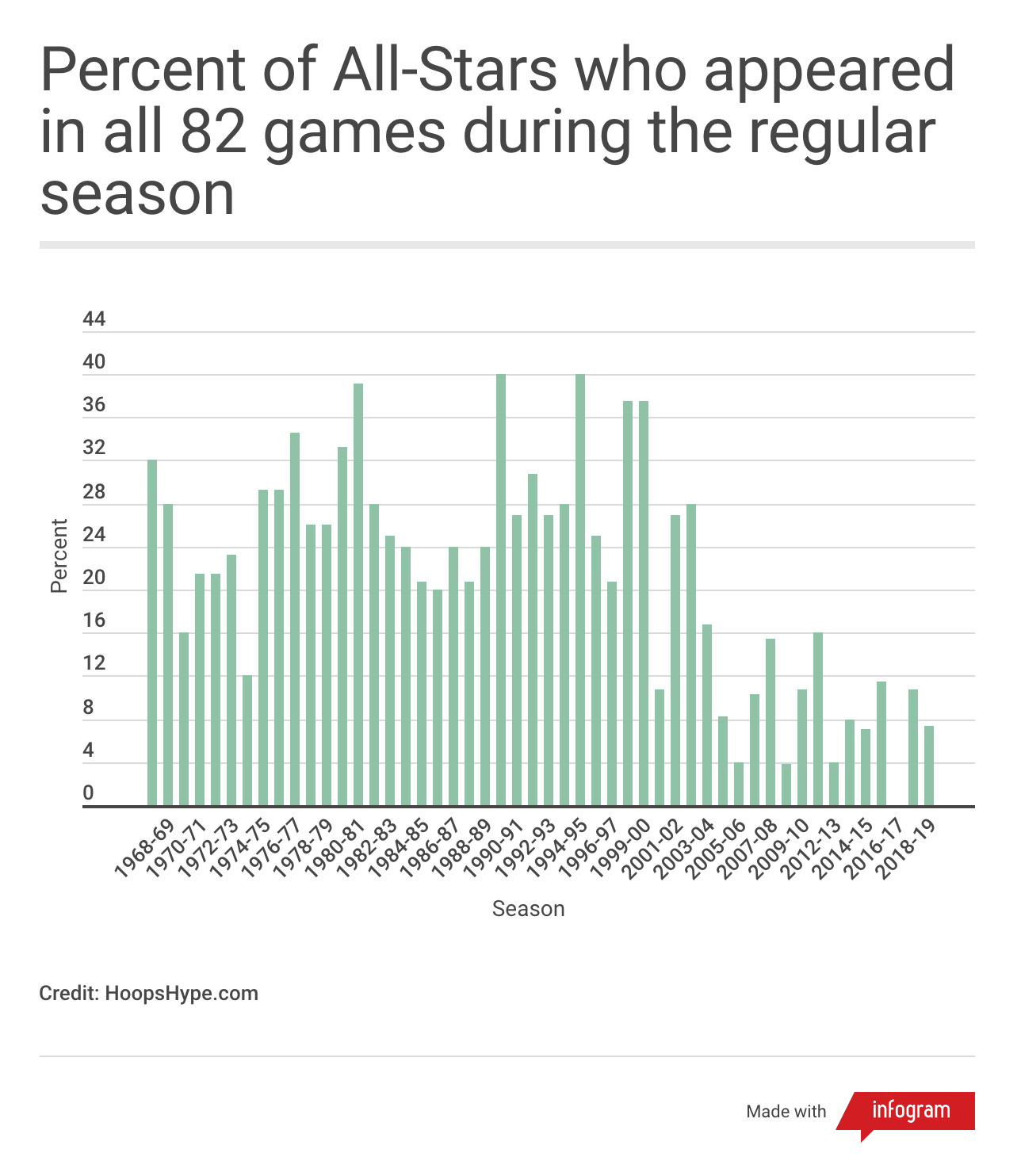In recent NBA seasons, fewer players have played all 82 games. This trend is due to various factors, including load management and injuries.
The NBA schedule is grueling, demanding peak performance over 82 games. Players face physical and mental challenges throughout the season. Playing every game is a remarkable achievement. It shows durability, consistency, and dedication. Fans and analysts often discuss this feat, highlighting the rarity in modern basketball.
Understanding how many players accomplish this can offer insights into the league’s current state. It also helps us appreciate the commitment required to endure an entire season without missing a game. So, how many NBA players played all 82 games? Let’s explore this interesting topic and find out.
Criteria For Inclusion
To determine how many NBA players played all 82 games, we need clear criteria for inclusion. This ensures accurate and fair assessment. Let’s break down the criteria into key components.
Defining An Nba Season
An NBA season includes 82 games. This covers both home and away games. The season starts in October and ends in April. Each team plays 41 home games and 41 away games. Players must participate in every game to be included.
Eligibility Requirements
Players must be on the active roster for all 82 games. This means they are not injured or suspended. Also, they must play in each game, not just be present. Coaches’ decisions to rest players do not count against them. If they sit out due to the coach’s choice, they are still eligible.
Players who meet these requirements are rare. It’s a significant achievement. It shows durability and consistency. These players contribute to their team’s success.
Historical Milestones
The NBA has seen many players achieve the remarkable feat of playing all 82 games in a season. This milestone not only showcases a player’s durability but also their commitment to the sport. Let’s delve into some of the key historical milestones related to this achievement.
First Players To Achieve 82 Games
In the early years of the NBA, playing all 82 games was a rare accomplishment. The first players to achieve this were celebrated for their endurance and consistency. These players set a high standard for those who followed.
One of the earliest players to achieve this was Johnny Kerr. He played all 82 games during the 1954-55 season. This was a significant milestone, showing that players could sustain a high level of performance throughout the entire season.
Notable Early Achievements
As the NBA grew, more players began to play all 82 games. This trend highlighted the increasing focus on fitness and conditioning. Notable early achievements include players who consistently reached this milestone in the 1960s and 1970s.
For example, Wilt Chamberlain played all 82 games in multiple seasons during the 1960s. His ability to maintain peak physical condition was remarkable. Another player, Walt Bellamy, also achieved this feat several times in his career, showcasing his resilience.
| Player | Season | Team |
|---|---|---|
| Johnny Kerr | 1954-55 | Syracuse Nationals |
| Wilt Chamberlain | 1961-62 | Philadelphia Warriors |
| Walt Bellamy | 1964-65 | New York Knicks |
These early milestones paved the way for future players. They showed that playing all 82 games was possible with the right preparation and dedication.
Modern Era Consistency
In the NBA, playing all 82 games in a season is a mark of consistency. The modern era has seen changes in how players are managed. Load management and injuries have affected player participation.
Recent Trends In Player Participation
In recent years, fewer players have played all 82 games. The 2018-2019 season saw only five players achieve this feat. This trend shows a shift in how teams manage their players.
| Season | Number of Players |
|---|---|
| 2018-2019 | 5 |
| 2017-2018 | 8 |
| 2016-2017 | 18 |
This decline in participation is notable. It reflects a focus on player health and longevity.
Impact Of Load Management
Load management is a key strategy in modern NBA. Teams rest players to prevent injuries and ensure peak performance. This strategy has reduced the number of players playing all 82 games.
- Resting key players during less critical games
- Reducing minutes for star players
- Prioritizing player health over game appearances
These practices aim to keep players fresh for playoffs. While beneficial for health, they affect game participation records.
In conclusion, the modern era of the NBA focuses on player health and longevity. This has changed the landscape of player participation.

Credit: fadeawayworld.net
Remarkable Streaks
NBA players who play all 82 games in a season exhibit exceptional endurance and dedication. This remarkable feat showcases their resilience and commitment to their teams. Such streaks often highlight athletes who consistently perform at their best, game after game. Let’s explore some of the most noteworthy streaks in NBA history.
Longest Consecutive Seasons
The longest consecutive seasons of playing all 82 games is a testament to a player’s durability. A few players have achieved this impressive record, cementing their status as ironmen of the sport. These athletes have managed to avoid significant injuries while maintaining peak performance.
One notable example is A.C. Green, who played all 82 games for eight straight seasons. His streak from 1986 to 1993 remains unmatched. Green’s incredible durability earned him the nickname “Iron Man.” His remarkable streak is a benchmark for player endurance in the NBA.
Players With Multiple 82-game Seasons
Several NBA players have achieved multiple 82-game seasons throughout their careers. These athletes demonstrate consistent excellence and reliability. Playing all 82 games in more than one season is a rare and commendable accomplishment.
Karl Malone, a legendary power forward, played all 82 games in 11 different seasons. His longevity and consistency were key to his impressive career stats. Another example is John Stockton, who played all 82 games in 16 seasons. Stockton’s durability contributed to his record-setting assists total.
These players have set high standards for durability and performance. Their multiple 82-game seasons highlight their exceptional physical conditioning and mental toughness.
Team Contributions
In the NBA, playing all 82 games in a season is a remarkable achievement. It requires not just individual resilience but also the support and strategy of the team. Teams with players who consistently play every game often see significant benefits, from improved chemistry to better overall performance.
Franchises With Most 82-game Players
Some franchises excel at maintaining player durability. These teams often have the most players completing all 82 games.
- Chicago Bulls: Known for their rigorous training and medical staff.
- San Antonio Spurs: Famous for effective player management and rest schedules.
- Utah Jazz: Focus on balanced playtime and physical conditioning.
Team Strategies For Player Durability
Teams employ various strategies to ensure player durability throughout the season. Here are some common practices:
- Load Management: Limiting minutes to prevent fatigue and injuries.
- Advanced Training Programs: Customized workouts for strength and recovery.
- Rest Days: Strategic rest periods to maintain peak performance.
These strategies not only help players stay fit but also contribute to the team’s overall success. By prioritizing player health, franchises can maintain a competitive edge throughout the long NBA season.

Credit: hoopshype.com
Position Analysis
The NBA season is long and grueling. Playing all 82 games in a season is an impressive feat. Position plays a significant role in the wear and tear players experience. Let’s dive into how different positions handle the demands of an entire NBA season.
Guards Vs. Forwards Vs. Centers
Guards, forwards, and centers each have unique roles. Guards are often the quickest and smallest players. They run the floor, handle the ball, and guard the perimeter. Forwards are versatile. They balance between inside and outside play. Centers are the tallest and strongest. They protect the rim and score close to the basket.
Position-specific Challenges
Each position faces different challenges. Guards face relentless pressure from opponents. They must navigate through defenses and make quick decisions. This constant movement increases their risk of ankle and knee injuries.
Forwards deal with physical play. They must fight for position and crash the boards. This can lead to shoulder and back issues. Their versatility also means they cover a lot of ground. This increases the risk of fatigue.
Centers face a different set of challenges. Their size and strength are crucial. But this also makes them prone to foot and knee problems. They battle for rebounds and block shots. This constant physical contact takes a toll on their bodies.
Health And Conditioning
Health and Conditioning play a crucial role in an NBA player’s ability to complete an entire 82-game season. The physical demands of basketball are intense, and maintaining peak condition is essential for performance and injury prevention. Let’s explore how players achieve this through training regimens and preventative measures.
Training Regimens
NBA players follow strict training regimens to stay in top shape. These routines include:
- Strength Training: Building muscle to withstand physical play.
- Cardio Exercises: Improving endurance for long games.
- Flexibility Work: Stretching to prevent injuries.
Each player has a personalized plan. Trainers adjust it based on individual needs. This tailored approach helps players maintain consistency and avoid overtraining.
Preventative Measures
Preventing injuries is as important as training. Players use various preventative measures:
- Proper Warm-Ups: Preparing muscles for intense activity.
- Hydration: Keeping the body functioning optimally.
- Recovery Sessions: Using ice baths and massages.
Teams also invest in technology. Wearable devices track players’ physical metrics. This data helps in identifying potential risks early. Players then adjust their routines accordingly.

Credit: hoopshype.com
Impact On Careers
The demanding NBA schedule tests every player’s resilience and determination. Playing all 82 games in a season is a significant achievement. This feat impacts a player’s career in many ways. It showcases their physical and mental toughness. Let’s explore the profound impact on their careers.
Longevity And Endurance
Playing all 82 games demonstrates a player’s durability. It shows their ability to withstand the season’s rigors. This endurance can extend their career. Teams value players who consistently stay healthy. Such players often have longer careers. Their longevity becomes an asset to any team.
Reputation And Legacy
Completing all 82 games boosts a player’s reputation. It highlights their commitment and reliability. Fans and peers respect such dedication. This respect can enhance a player’s legacy. They are remembered as dependable and tough. Their consistent performance leaves a lasting mark on the sport.
Frequently Asked Questions
How Many Nba Players Played All 82 Games?
In the 2022-2023 NBA season, only a few players managed to play all 82 games. It’s a rare feat due to the season’s physical demands and injuries.
Why Is It Rare For Nba Players To Play All 82 Games?
It’s rare because the NBA season is physically demanding, and players often face injuries or need rest to avoid fatigue.
Who Played All 82 Games In The 2022-2023 Season?
A few notable players completed all 82 games in the 2022-2023 season. Specific names can vary, but it’s a small, elite group.
How Does Playing All 82 Games Impact A Player’s Career?
Playing all 82 games can boost a player’s reputation for durability and consistency. However, it can also increase the risk of injury.
Conclusion
Consistency in the NBA is rare. Playing all 82 games is an achievement. It shows dedication and endurance. Few players reach this milestone each season. Their resilience inspires fans and teammates. It highlights the importance of fitness and perseverance. Every game matters in such a long season.
Players who manage this feat earn respect. Their commitment sets a high standard. Celebrate these athletes for their remarkable effort. They remind us of the value of hard work.




